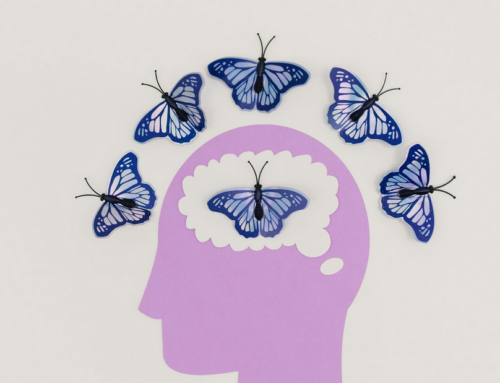According to the National Association of Anorexia Nervosa and Associated Disorders (ANAD), eating disorders are thought to affect at least 9% of the world’s population.(1) Autism and ADHD are both conditions that are highly correlated with eating disorders. 3-10% of children and young adults with eating disorders also have autism, while ADHD is considered to be a frequently missed diagnosis among many people who are diagnosed with eating disorders.(1)
Since the arrival of the COVID-19 pandemic, The National Eating Disorder Association has noted a more than 50% increase in calls to its hotline. (2) Teenagers and young adults have made up a large part of the call volume. This makes sense, as eating disorders are often associated with a need for control during a difficult and confusing time. The increased amount of time spent online and on virtual calls for both children and adults, coupled with the loss of enjoyable activities and socialization, may have also led to erratic eating and exercise habits that have fueled eating disorders.(2)
In the past few years, however, research is beginning to show that developing an eating disorder is likely more than just experiencing a situational trigger. Instead, eating disorders seem to stem from a combination of different factors, including neurological differences.
Types of Eating Disorders
When someone thinks of an eating disorder, they usually think of anorexia, a condition associated with limiting and restricting food, or bulimia, a condition associated with bingeing and purging. There is also a type of eating disorder known as binge eating disorder. With binge eating disorder, a person frequently eats large quantities of food in a manner that feels out of their control. (4)
Some types of disordered eating don’t fall squarely into any one category. These disorders are known as eating disorders not otherwise specified.(4)
The Genetics of Eating Disorders
While eating disorders have long been thought of as a response to cultural or societal expectations, there are certain facts about eating disorders that go beyond life experiences. For instance, eating disorders tend to run in families. (3) Different family members might have different eating disorders, but the common thread still runs through the family. Researchers think that this genetic tendency means that there could be a neurological weakness present at birth that makes someone more susceptible to developing an eating disorder. (3)
Individuals with eating disorders also tend to have a specific personality type. As children, people who go on to develop disorders like anorexia or bulimia are usually more anxious, perfectionistic, and obsessive than other kids.(3)
Eating Disorders and Neurology Research
Anyone of any gender can develop an eating disorder, but these conditions tend to be more common in women. As a result, much of the research into eating disorders has been done on women. (3)
Imaging studies done on the brains of women with anorexia have found that they process rewards differently. In one study, when women with anorexia played a game that involved making bets, the parts of the brain that are associated with reward processing were more active after losing the game, rather than winning. The opposite was true in women who did not have anorexia. (3)
Other studies have found that dopamine, a chemical substance in the body that helps us feel pleasure, responds differently in people with different eating disorders than people without eating disorders.(3) Structural differences in the brain may be present, too. For instance, the part of the brain that lets us know when to stop eating looks different in people with eating disorders. (3) Meanwhile, the part of the brain that is associated with forming habits is more active in studies of women with anorexia.(3) This has led some researchers to wonder if anorexia is related to habitual behaviors, rather than willpower. (3)
Research has uncovered other differences, too. Imaging scans have also shown that women with anorexia seem to be hypersensitive to their own bodies. It is thought that this might contribute to their tendency to be anxious. (3) Their sensitivity to normal feelings within their body — such as the feeling of their heartbeat — might make them prefer the feelings that come with starvation, as everything in the body then slows down. (3)
Can Neurobiology Lead to Better Treatments for Eating Disorders?
When studying the brain of a person with an eating disorder, It’s difficult to know for certain if these changes were present before the eating disorder or after its development. (3) Eating disorders can, understandably, damage the body and change how the brain functions. However, simply being able to see the differences in the brains of people with eating disorders could lead to better, more effective treatments.
Eating disorders can be dangerous and relapse rates are high. If researchers could target certain areas of the brain with medications or therapies, then people with eating disorders will be more likely to lead healthy lives.
Services at NeuroBehavioral Associates
NeuroBehavioral Associates provides comprehensive neuropsychological assessments to evaluate children, teenagers, and adults with known or suspected neurodevelopmental, learning, or attention disorders. We also offer a variety of other services, including therapies, resources, and referrals.
NeuroBehavioral Associates has remained open during the COVID-19 pandemic. Our practice maintains a low-contact testing strategy that includes the maintenance of social distancing, as well as certain telehealth tools to complement our in-office visits. Contact us today at 410-772-7155 to schedule an appointment or to learn more about how our services could help you or your child.
References
- National Association of Anorexia Nervosa and Associated Disorders. (2021, March 3). Eating Disorder Statistics | General & Diversity Stats | ANAD. https://anad.org/get-informed/about-eating-disorders/eating-disorders-statistics/
- Edwards, E., Galante, A., & Gosk, S. (2021, May 25). Pandemic created “perfect storm” for eating disorders in teens. NBC News. https://www.nbcnews.com/health/health-news/pandemic-created-perfect-storm-eating-disorders-teens-n1268331
- Weir, K. (2016, April). New insights on eating disorders. American Psychological Association. https://www.apa.org/monitor/2016/04/eating-disorders
- NEDA. (2021). What are eating disorders? National Eating Disorders Association. https://www.nationaleatingdisorders.org/information-eating-disorder






